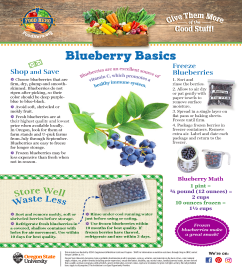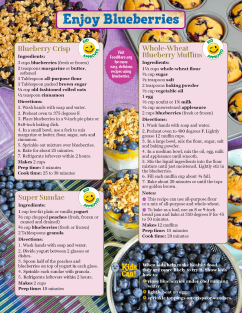Blueberry Basics
Blueberries are an excellent source of vitamin C, which promotes a healthy immune system.
Shop and Save
- Choose blueberries that are firm, dry, plump and smooth-skinned. Blueberries do not ripen after picking, so their color should be deep purple-blue to blue-black.
- Avoid soft, shriveled or moldy fruit.
- Fresh blueberries are at their highest quality and lowest price when available locally. In Oregon, look for them at farm stands and U-pick farms from July through September. Blueberries are easy to freeze for longer storage.
- Frozen blueberries may be less expensive than fresh when not in season.
Store Well Waste Less
- Sort and remove moldy, soft or shriveled berries before storage.
- Refrigerate fresh blueberries in a covered, shallow container with holes for air movement. Use within 10 days for best quality.
- Rinse under cool running water just before using or eating.
- Use frozen blueberries within 10 months for best quality. If frozen berries have thawed, refrigerate and use within 3 days.
Freeze Blueberries
- Sort and rinse the berries.
- Allow to air dry or pat gently with paper towels to remove surface moisture.
- Spread in a single layer on flat pans or baking sheets. Freeze until firm.
- Package frozen berries in freezer containers or freezer bags. Remove extra air. Label and date each package and return to the freezer.
Blueberry Math
1 pint = 3/4 pound (12 ounces) = 2 cups
10 ounces frozen = 1 1/2 cups
Frozen blueberries make a great snack!
Enjoy Blueberries
Recipes
Blueberry Crisp
Super Sundae
Whole-Wheat Blueberry Muffins
Kids Can!
When kids help make healthy food, they are more likely to try it. Show kids how to:
- rinse blueberries under cool running water.
- lightly beat an egg.
- sprinkle toppings on crisps or sundaes.




